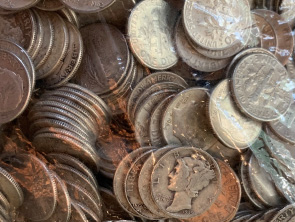
Simple guide to Understanding Key Dates in Numismatics: A Look at the $20 Gold Coin
In the fascinating world of numismatics, or coin collecting, “key dates” represent one of the most intriguing aspects that can significantly affect a coin’s value and desirability. These are specific years of issuance that are considered rare or significant due to low mintage, historical context, or errors during production. Understanding key dates can greatly enhance a collector’s ability to recognize valuable pieces and build a meaningful collection. This article explores the concept of key dates using the $20 gold coin, also known as the Double Eagle, as a prime example.
The Importance of Key Dates
Key dates are essentially the cornerstone of coin collecting. They are the editions within a coin series that were produced in smaller quantities or under unique circumstances, making them harder to find today. Collectors often seek these out first when trying to complete a series because they provide not only the challenge but also the potential for significant appreciation in value.
The $20 Gold Coin (Double Eagle)
The $20 gold coin, particularly the Saint-Gaudens Double Eagle, offers a clear illustration of how key dates function within the realm of numismatics. Minted from 1907 to 1933, this coin is celebrated for its artistic design and its role in American monetary history. The Double Eagle was a cornerstone of international trade and finance during the early 20th century.
Key Dates of the $20 Gold Coin
- 1933 Saint-Gaudens Double Eagle: Undoubtedly the most famous key date among all $20 gold coins is the 1933 Saint-Gaudens Double Eagle. This coin never officially circulated because President Franklin D. Roosevelt took the U.S. off the gold standard in 1933, and most of the coins were melted down. Only a few specimens escaped, and these are now among the most valuable coins in the world. One sold at auction in June 2021 for a record-breaking $18.9 million.
- 1907 High Relief, Wire Rim: Another significant key date is the 1907 Saint-Gaudens High Relief Double Eagle with the Wire Rim. This version was among the first struck of Augustus Saint-Gaudens’ designs and featured a high relief that made it difficult to stack and impractical for mass production. Its striking beauty and low mintage make it highly prized by collectors.
- 1921: The 1921 Saint-Gaudens Double Eagle saw a very low mintage, with only 528,500 coins produced. This year is considered rare and commands a high premium in the coin collecting market. Its rarity is attributed to the post-World War I economic recession, which reduced the demand for new coinage.
- 1927-D: The 1927-D Saint-Gaudens Double Eagle is another rare key date, with only 180,000 pieces minted. It is considered one of the great rarities in all of U.S. numismatics due to its very low survival rate, as most were melted down during the Great Depression.
Why Collect Key Dates?
Collecting key dates is not only about the thrill of the hunt but also about the potential for financial investment. Key date coins like those from the $20 gold coin series are often the highlights of auctions and can appreciate in value considerably over time, especially in good condition. Additionally, these coins carry historical significance that adds to their narrative value and appeal.
In numismatics, key dates are essential for understanding the broader context of a coin series, as well as for appreciating the nuance of historical minting variations. For collectors, key dates like those found in the $20 gold coin series represent the pinnacle of the hobby, offering both a connection to the past and a potential for future gain.
The Crucial Role of Key Dates in Inherited Coin Collections
Inheriting a coin collection or acquiring one from an estate sale can be an unexpectedly valuable proposition. For those who find themselves the stewards of such collections, understanding the importance of key dates within these collections is crucial. Key date coins are often hidden gems that could significantly increase the overall value of the collection. This article explores why key dates are vital in coin collecting and how to identify and evaluate these coins in an inherited collection.
Understanding Key Dates
Key dates refer to the years during which a particularly low number of coins were minted, or during which coins were minted with unique variations or errors. These factors often make key date coins rare and highly sought after by collectors and investors alike. The rarity and historical significance of these coins can make them substantially more valuable than their common counterparts.
Why Key Dates Matter in Inherited Collections
- Value Identification: The first step after inheriting a coin collection is identifying what you have. Key date coins may look similar to less valuable ones but can vastly increase the collection’s worth. Recognizing these can help in assessing whether you have a hidden treasure.
- Insurance and Appraisal: Knowing the value of key date coins in your inherited collection is crucial for accurate insurance and estate valuation. Properly appraising the collection ensures that it is insured against loss, theft, or damage for its true worth.
- Strategic Decisions for Collectors: For collectors, identifying key dates can influence decisions about keeping, selling, or expanding the collection. Knowing the highlights of your collection can guide strategic choices that align with your collecting goals.
- Historical Significance: Key date coins often carry a rich history that can be fascinating to uncover. They can serve as a window into the economic, political, and social dynamics of their time, adding a layer of historical appreciation to the collection.
How to Identify Key Dates in an Inherited Collection
- Research: Start with basic research on the types of coins in the collection. Look up minting years and figures to identify which coins were produced in significantly lower quantities.
- Consult Resources: Utilize coin catalogues, online databases, and numismatic reference books. Websites like the Professional Coin Grading Service (PCGS) or the Numismatic Guaranty Corporation (NGC) offer detailed information about coin issues, rarity, and key dates.
- Seek Professional Appraisal: For potentially valuable collections, it’s advisable to seek a professional appraisal. Expert numismatists can provide not only a valuation but also a wealth of information regarding the rarity and importance of each piece.
- Attend Coin Shows or Clubs: Engaging with other collectors at shows or club meetings can provide insights and second opinions on the significance of certain coins in your collection.
The Importance of Preservation
Once key dates are identified, proper care and preservation are paramount. Handling and storage conditions can affect the value of these coins. Using appropriate materials for storage and avoiding unnecessary handling can help preserve their condition and, by extension, their value.
Conclusion
Inheriting a coin collection comes with the responsibility of preservation and the opportunity of potentially significant financial benefit. Understanding and identifying key date coins within your inherited collection is essential for maximizing its value. Whether you choose to continue collecting, sell the collection, or simply preserve it as a family heirloom, recognizing the importance of these coins is a crucial first step in the journey of numismatic stewardship.
By paying attention to key dates, you not only honor the legacy of the original collector but also enhance the potential future worth of the collection.


